QUESTA CONVERSAZIONE SI È SVOLTA A FIRENZE IN OCCASIONE DELLA PARTECIPAZIONE DI CHARLEMAGNE PALESTINE ALL’ESIBIZIONE DONNA DONNE (6 OTTOBRE 2005 – 8 GENNAIO 2006) CURATA DA ADELINA VON FÜRSTENBERG A PALAZZO STROZZI.
Roberto Lambarelli: Quando hai cominciato a fare installazioni con i burattini, le bambole e i peluches?
Charlemagne Palestine: Tutto è cominciato, come si dice, nella notte dei tempi, migliaia di anni fa, prima dell’Inquisizione. Tutto si riflette nei diversi aspetti del mio lavoro, negli Arlecchini, nei Pulcinella.
RL: I pupazzi e gli altri materiali che usi li trovi o li acquisti?
CP: Il percorso è sempre differente. A volte li cerco, altre volte essi arrivano da soli. Li aspetto, come se fossi uno sciamano, e loro arrivano.
Faccio queste frivolezze da molto tempo, le persone mi portano i giocattoli dei loro bambini che poi diventano personaggi veri e propri del mio lavoro, per le installazioni, le sculture, le performance, i video. Li uso come spugne di spiriti che assorbono memorie ed esperienze dell’infanzia che contengono. I miei assemblaggi sono sempre legati alla storia e alle tradizioni degli oggetti che sono sempre stati importanti per me.
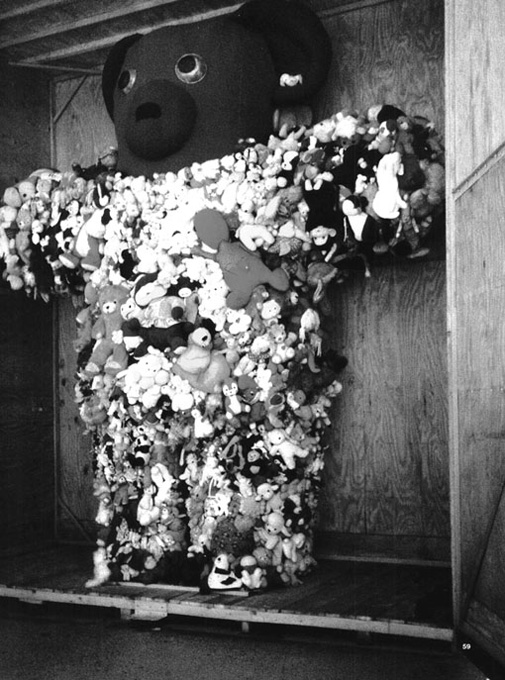
RL: Il lavoro in mostra intitolato A Temple of Schmattes for Shirley è dedicato a tua madre?
CP: In realtà alla famiglia di mia madre. Loro provengono da generazioni di artigiani tessili e suo padre faceva tende da sole. Molte tende erano fatte di tessuti a righe per i negozi eleganti di New York. Possiamo dire che lui cuciva e costruiva come Daniel Buren sessant’anni prima che egli li scoprisse. Quando ho incontrato Daniel Buren e siamo diventati amici, gli ho detto che secondo me, visto che anche lui viene da una famiglia ebrea, le sue strisce potrebbero essere originate da un continuum folklorico di una solida, antica affinità. Certo questa è un’interpretazione del tutto personale. Daniel non è stato né d’accordo né contrario, ha semplicemente riso.
RL: Questa tua installazione sembra un piccolo teatro…
CP: Non proprio un teatro, piuttosto un altare.
RL: Ci sono tutti quei drappi…
CP: Sì quelli sono gli schmattes, in yiddish medievale; dei pezzi di tela…
RL: Ci sono molti oggetti in questo lavoro: peluches, piccoli pupazzi di plastica e altre cose da bambini appese al soffitto e, inoltre, tutta la stanza è rivestita di stoffe, di tende molto colorate. Insomma, non trovi che ci sia una profusione che si oppone alla tua musica, che è stata definita “minimalista”?
CP: Oggi io dico di essere un massimalista. Questa è un’installazione massimalista. Le mie installazioni sono massimali. Mi sono sempre considerato un massimalista. L’inventore della parola minimal l’ha usata per descrivere una certa tendenza nel suono, ma le mie sonorità, anche se a volte sembrano minimali per chi le ascolta dal di fuori, passano a essere massimali una volta che alla fine ci si entra e si lascia che, con le loro tonalità e i loro tempi, ti portino in un’avventura sonora infinita. L’essere minimal non è nella mia natura e non lo è mai stato. Sono sempre stato “maximal”. Tra le due parole “minimal” e “maximal” c’è una fondamentale differenza che riguarda due lettere, il suffisso “in” del “min” significa, per me, essere “in” come dire chiuso, imprigionato, come mi sono sentito per anni dovendomi portare addosso quella definizione che odio. Mentre c’è l’“ax” di “max” che vuol dire ascia, lo strumento con cui puoi distruggere la tua prigione. Inoltre, “in” può voler dire appartenenza a un gruppo, cosa di cui io non mi sono mai sentito parte. Ho tagliato drasticamente i rapporti con il gruppo, nel senso che nella mia vita, come artista e come essere umano, ho spezzato i miei legami con loro prendendo strade varie, diverse.
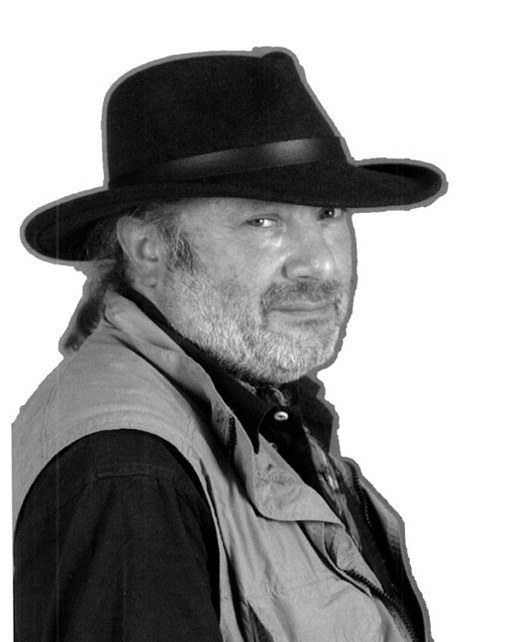
RL: Dietro il gioco di parole, che ha un sapore concettuale, mi sembra di scorgere qualcosa di molto importante, un’implicazione esistenziale e, allo stesso tempo, un distacco dalla vita, un po’ orientale in un certo senso…
CP: Vengo da Brooklyn, da un quartiere popolare dove giocavamo con le parole e inventavamo uno slang che spesso era più colorito dell’inglese che imparavi a scuola. Quando sono arrivato a Roma, 35 anni fa, invitato da Fabio Sargentini, non ero molto diverso. Lì ho incontrato La Monte Young, Terry Riley (Roberto, ho incontrato Prân Nath a New York 3 o 4 anni prima che arrivassi a Roma, separatamente da Young e Riley), ma il mio orientalismo deriva dalla mia infanzia, dalla sinagoga, come il mio rapporto con i tessuti mi viene da quello secolare della famiglia di mia madre. Come il mio approccio al fare le cose, come il cantare e il correre che ho inventato per Body Music 1 & 2 per Maria Gloria Bicocchi di Art/Tapes/22. Ho continuato questo lascito, questo ascetismo. Tutto mi riporta alle mie radici e il legame che ho con la mia famiglia, con la mia razza e la mia religione e, ovviamente, anche con le mie esperienze di giovane newyorchese di Brooklyn dopo la guerra nella “Little Odessa”. Negli anni ’80, poi, ho fondato una compagnia di film-video con l’intento di salvare i rituali a rischio di scomparsa di altri popoli antichi; i nativi americani, i polinesiani, quelli che erano in pericolo di diaspora come gli ebrei dopo l’olocausto. Il legame con tutta questa antichità è forse quello che tu chiami il mio ascetismo, ma è anche la base del mio senso della modernità. In tutte queste culture multi-ritualistiche ho trovato il primo “Gesamtkunstwerk”, il lavoro di arte totale, danze e canzoni e architettura e costumi e tradizioni e leggende e riti religiosi e rituali. Questa è la mia versione di arte totale, Charlemagne il musicista, Charlemagne lo sciamano, Charlemagne lo scultore, Charlemagne il performer, Charlemagne il pazzo, l’Arlecchino, il Pulcinella, il clown, il mostro, il diavolo, l’angelico, il melanconico. The Total Maximal Charlemagne.
RL: Mi racconti del tuo esordio nella scena artistica newyorkese? C’era già la musica minimalista?
CP: No, non c’era ancora, è venuta più tardi. All’inizio si usavano altre definizioni per il mio tipo di musica. Molta di questa musica era chiamata «trance music». Ci volle un po’ di tempo prima che si cominciasse a parlare di musica minimalista. Fino ad allora il termine minimal era usato per le arti plastiche, per artisti come Tony Smith, Sol LeWitt, Richard Serra, Carl Andre. Poi Tom Johnson, critico e compositore, scrivendo per il «Village Voice» usò per primo il termine minimal music per il gruppo di musicisti conosciuti come il «Downtown Group» perché la maggior parte di noi abitava nella nuova SoHo. Facevamo i nostri lavori agli opening di Kitchen e di altre gallerie del centro.
RL: Non trovi che ci sia una sorta di continuità fra le tue ricerche degli anni Settanta e quelle di molti giovani di oggi che vanno attraversando i diversi linguaggi?
CP: Sì, sicuramente anche molti giovani compositori/performer/artisti si muovono all’interno di diversi linguaggi come noi facevamo negli anni ’60 e ’70.
Essere “multi” era normale allora. Poi, più tardi, alla fine degli anni ’70, sono tornate le divisioni, le specializzazioni. Per un musicista, io sono un musicista, ma io danzo anche. Quando lavorai con Simone Forti cominciai come collaboratore musicale, ma subito dopo cominciai a produrre suoni e a muovermi contemporaneamente. Musica e danza. Non ero un danzatore per formazione, ma mi mossi in un unico modo con il mio corpo maschile nello spazio. Anche i dervisci non sono ballerini in senso stretto…
Arte e Critica, n. 45, Gennaio – Marzo 2006, pp. 20-22.
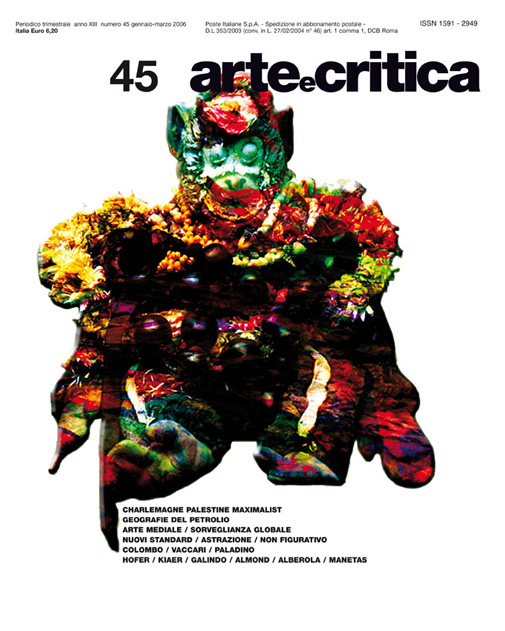
THIS CONVERSATION TOOK PLACE IN FLORENCE ON THE OCCASION OF CHARLEMAGNE PALESTINE’S PARTICIPATION IN THE EXHIBITION WOMAN WOMEN (6 OCTOBER 2005 – 8 JANUARY 2006) CURATED BY ADELINA VON FÜRSTENBERG AT THE PALAZZO STROZZI.
Roberto Lambarelli: When did you start to make installations using puppets, dolls and little rag animals?
Charlemagne Palestine: Everything began, as it is said, in the mists of time, a thousand years ago, before the Inquisition took place. Everything is reflected in the different aspects of my work, in Harlequins, in Pulcinellas.
RL: Do you buy or rather find puppets and other materials you use?
CP: The path is always different. Sometimes I look for them, other times they arrive by themselves. I wait for them, as if I were a shaman, and they come to me.
I do these trifles since a long long time; people bring me their children’s toys that then can become integral personages in my works, for installations, sculptures, performances and videos. I use them as spirit sponges absorbing memories and experiences of childhood that they contain. My assemblages are always linked to the history and tradition of the objects which has always been important to me.
RL: The work in the exhibition titled A Temple of Schmattes for Shirley is dedicated to your mother?
CP: Better said, it is dedicated to my mother’s family. They come from centuries of textile artisans and her father was an awning maker. Many awnings were made from cloth with stripes for elegant shops in New York City. We might say he was already sewing and constructing Daniel Burens 60 years before he discovered them. When I actually met Daniel Buren and we became friends I proposed to him that perhaps as he also is from a Jewish family that his stripes might have originated at a folkloric continuum of an already established ancient affinity. This is my personal interpretation of course and Daniel never agreed or disagreed, he just laughed.
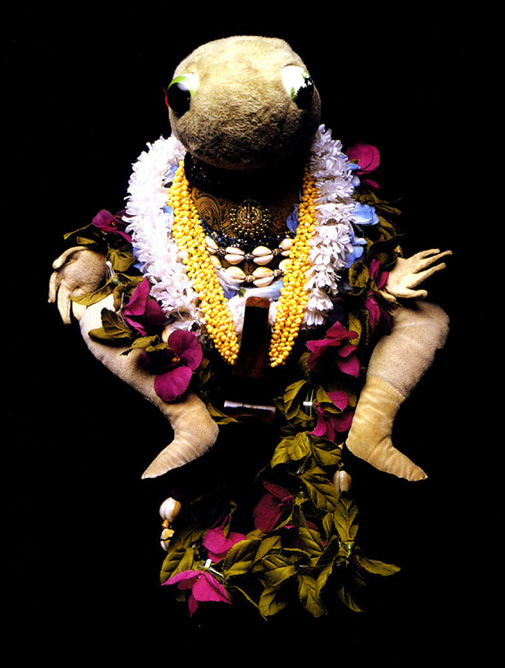
RL: Your installation looks like a small theatre.
CP: Not really a theatre but more of an Altar.
RL: There is all that drapery…
CP: Yes, those are the schmattes, in Yiddish of the middle ages; pieces of rags…
RL: There are many objects in this work: stuffed toys, small plastic puppets and other children’s things hanging from the ceiling and moreover the entire room is covered with fabrics with very colorful curtains. So don’t you think that there is a profusion that opposes your music, which was defined as minimal?
CP: Today I say I am a maximalist. This is a maximalist installation. My installations are maximal. I have always considered myself a maximalist. The inventor of that word minimal used it to describe a certain tendency in sound but my sonorities though sometimes deceptively minimal to those listening from the outside turn maximal once you finally enter the sonorities and let them and their overtones and beats take you on a never ending sonorous adventure. It’s not my nature to and never was to be minimal I have always been maximal. Between the 2 words minimal and maximal there are fundamental differences that regard 2 letters, the ‘IN’ of min means to me being ‘In’ like enclosed, imprisoned as I felt for years having to wear that description that I hate. Otherwise there is ‘AX’ of Max which means the axe, the tool with which you can break out of your prison. Also ‘In’ can mean belonging to group which I never felt a part of. I axed myself from this group meaning to chop my connection with them by taking so many varied and diverse routes in my life as artist and human being.
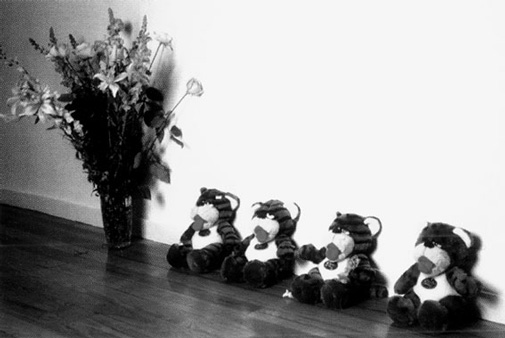
RL: Beyond the word game that has a conceptual feel, I notice something very important, an existential implication, and at the same time a detachment from life. A little bit oriental in a sense.
CP: I come from Brooklyn, from a working class neighborhood where we played a lot with words and even invented a slang that was often more colorful than the English learned in school. When I arrived in Rome 35 years ago invited by Fabio Sargentini, I wasn’t any different. There I met La Monte Young, Terry Riley (Roberto, I met Prân Nath in NYC 3 or 4 years before I ever arrived in Rome, separate from Young and Riley) but my orientalism comes from my childhood, from the synagogue, like my relationship to textiles coming from centuries on my mother’s side of the family. Similarly my approach at doing things, like singing and running that I invented for Body Music 1 & 2 for Maria Gloria Bicocchi of Art/Tapes/22. I continued that legacy, that asceticism. It all returns me to my roots and the connection that I have with my family, with my race and religion and of course also my experiences as a young Brooklyn New Yorker after the war in ‘Little Odessa’.
In the 80’s then I founded a film-video company with the purpose of salvaging the rituals in threat of vanishing of other ancient peoples; the Native Americans, the Polynesians, who are in danger of disparition like we the Jews after the holocaust. Linking with all this ancientness is perhaps what you call my asceticism but it also is the basis of my sense of modernity. In all these multi-ritualistic cultures I found the first ‘Gesamtkunstwerk’, the total art work, dances and songs and architecture and costumes and customs and legends and religious rites and rituals. Here I am with my version of total art, Charlemagne the musician, Charlemagne the shaman, Charlemagne the sculptor, Charlemagne the vidéaste, Charlemagne the performer, Charlemagne the fool, the Harlequin, the Pulcinella, the clown, the monster, the devil, the angelic, the melancholy. The Total Maximal Charlemagne.
RL: Can you tell me about your beginnings on the New York art scene? Was minimal music already there?
CP: No, it wasn’t already there, it came later. At first other definitions were used for my kind of music. Much of this music was called “trance music.” It took a while before they started talking about minimal music. Until then minimal was used for the plastic arts, artists like Tony Smith, Sol LeWitt, Richard Serra, Carl Andre. Tom Johnson, critic and composer then writing for the ‘Village Voice’, first used the term minimal music for the group of musicians known as the ‘Downtown Group’ as most of us lived in the new SoHo and performed our works at the Kitchen and other downtown gallery venues.
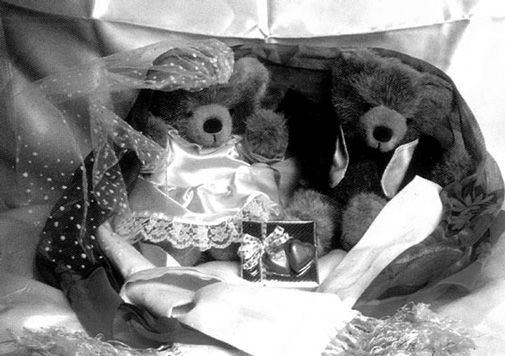
RL: Don’t you think that there is a sort of continuity between your researches of the 70’s and those of many youths today that go through the different languages?
CP: Yes, sure also some young composer/performers/artists move amongst different languages as we did in the 60’s and 70’s. To be multi was normal at that time. Then later in the late seventies the division and specialization returned. For a musician, I am a musician but I also dance.
When I worked with Simone Forti I began as a musician collaborator but immediately after I began to make sounds and move all together, music and dance. I wasn’t a dancer by education but I moved in a unique way with my male body in space. Also dervishes aren’t dancer in the strict sense…
Arte e Critica, no. 45, January – March 2006, pp. 20-22.


